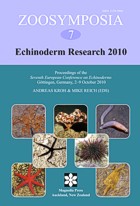Abstract
Harlequin crabs, Lissocarcinus orbicularis, are commensals found on the integument and in the buccal/cloacal cavity of several species of holothuroids. The population of these crabs was investigated on holothuroids of the barrier reef of Toliara (South-West of Madagascar) from 2002 to 2008. Seventeen holothuroid species were observed and eight were crab hosts. There is generally one adult crab or a heterosexual pair per infested holothuroid but up to ten juveniles were recorded on a Thelenota ananas. Carapace length of the observed L. orbicularis was from 0.3 to 1.4 cm from the tip of the rostrum to the end of the cephalothorax, with a mean length of 0.85 cm. L. orbicularis is characterized by a weak sexual dimorphism (females are bigger than males) and the presence of pereiopods morphologically adapted to fixation on the host integument. Gravid females were observed at each month of the survey indicating that the crab reproduces all the year. Considering our results and personal observations, we also discuss the monogamy mating system of the Harlequin crab.

